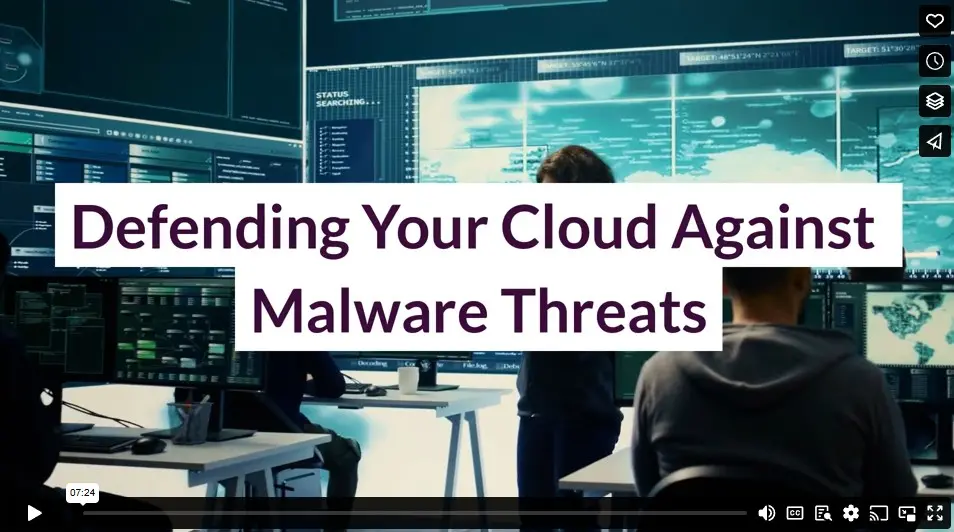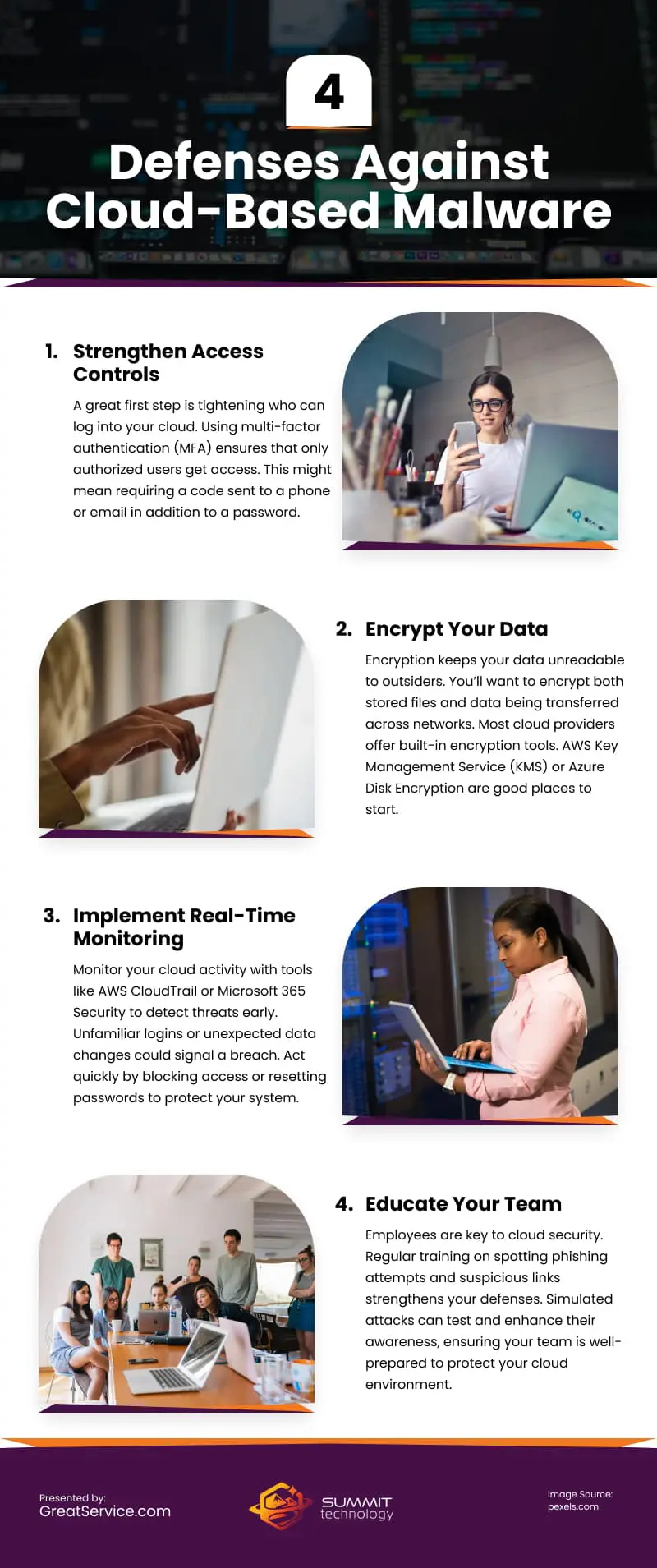If your business relies on the cloud for storing data or running operations, the last thing you want is an attack that locks you out or compromises sensitive information. That’s exactly what cloud malware is designed to do.
From ransomware that freezes your files to phishing attacks that steal login credentials, cloud malware can disrupt your workflow and put your reputation on the line. The rise in cloud-based operations means these threats are more common than ever.
So, how can you stay ahead of these risks? Here’s a look at the most common types of cloud malware and actionable steps to protect your cloud environment.
What Is Cloud Malware?
Cloud malware is a type of cyber threat that specifically targets cloud services like Microsoft 365, Google Workspace, or AWS. Instead of infecting your computer directly, these threats focus on attacking the online services your business uses every day.
The attackers behind cloud malware may try to steal passwords, exploit security gaps, or use automated scripts to gain access to your cloud accounts. Once they’re in, they can steal sensitive data, send spam, or misuse your cloud resources.
Common Types of Cloud Malware
Every business using cloud services needs to understand the threats they face. Here are the most common types of cloud malware that could impact your operations:
DDoS Attacks
When attackers flood your cloud services with overwhelming traffic, legitimate users like your employees and customers can’t get through. Your email stops working. Your customer service platform goes down. Your team can’t access critical tools. One attack can bring your entire business to a standstill.
Ransomware
Cloud ransomware encrypts your data across multiple services at once. Your team may arrive at work to find they can’t access any files, databases, or applications. Everything stays locked until you pay the ransom. For businesses that rely on cloud services, the impact can be catastrophic.
Data Exfiltration
This silent threat lets attackers steal your sensitive information without detection. They quietly copy customer data, financial records, and intellectual property. Most businesses don’t realize they’ve been compromised until their data appears for sale on the dark web or competitors suddenly have their trade secrets.
Trojan Malware
Trojans in cloud environments disguise themselves as legitimate software but have malicious capabilities. Once inside a cloud system, they can steal data, install additional malware, or provide attackers with remote access. These threats are particularly dangerous because they often bypass traditional security measures by appearing legitimate.
Live Migration Exploits
A newer threat targets the live migration process cloud providers use to move running virtual machines between servers. Attackers exploit this process to intercept data or install malware on target machines during the migration, often taking advantage of insufficient security measures.
Hypervisor Attacks
A hypervisor is the core software that creates and runs virtual machines in cloud environments. Hypervisor attacks exploit vulnerabilities in the hypervisor to gain control over multiple cloud systems and services. A successful attack at this level gives attackers broad access to your cloud environment, potentially affecting all your cloud-based operations and data.
The Real Impact of Cloud Malware
Cloud malware attacks can devastate your business in multiple ways. Understanding these consequences helps emphasize why protection is crucial:
Immediate Financial Impact
A successful cloud malware attack can drain your finances through ransomware payments, system recovery costs, and lost business during downtime. When critical systems are compromised, every minute of disruption can cost hundreds or thousands of dollars.
Business Disruption
Cloud malware can bring your operations to a standstill. When your team can’t access critical cloud systems, productivity plummets. Customer service suffers, orders go unfilled, and business momentum grinds to a halt.
Long-term Reputation Damage
Perhaps most devastating is the loss of trust from customers and partners. News of a security breach can drive away business and damage your brand for years to come. Many small businesses never fully recover from major cloud security incidents.
Combating Malware Threats in Your Cloud
Keeping your cloud environment secure doesn’t have to be complicated. Simple strategies can help protect your data and keep your systems running smoothly. Here are four ways to defend against cloud malware threats.
Strengthen Access Controls
A great first step is tightening who can log into your cloud. Using multi-factor authentication (MFA) ensures that only authorized users get access. This might mean requiring a code sent to a phone or email in addition to a password.
It also helps to encourage stronger passwords. Short, simple ones are easy for attackers to guess. A password manager can help your team create and save secure passwords without adding extra work.
Encrypt Your Data
Encryption keeps your data unreadable to outsiders. You’ll want to encrypt both stored files and data being transferred across networks.
Most cloud providers offer built-in encryption tools. AWS Key Management Service (KMS) or Azure Disk Encryption are good places to start.
You can also add a third-party encryption tool for extra security. This is especially useful for handling sensitive customer or financial information.
Implement Real-Time Monitoring
Keep an eye on your cloud activity to catch threats before they escalate. Use tools like AWS CloudTrail or Microsoft 365 Security to track unusual login attempts, unexpected file changes, or other suspicious behavior.
If you notice unfamiliar devices logging in or unusual data downloads, it might mean someone is trying to breach your system. Take immediate action, such as blocking access or resetting passwords, to stop the threat in its tracks.
Educate Your Team
Your employees play a huge role in cloud security. If they don’t know how to recognize phishing attempts or suspicious links, your defenses weaken.
Host regular training sessions to teach them what to watch out for. You can also simulate attacks to test their knowledge and improve their awareness. The more prepared your team is, the better your cloud’s defenses will be.
Final Thoughts
Sometimes, managing all these steps on your own can feel overwhelming. That’s where partnering with an IT managed services company comes in.
These providers take the stress off your plate by handling security monitoring, compliance updates, and cloud optimization. If you’re unsure about setting up network segmentation or managing encryption tools, they can guide you or even manage the entire process for you.
Plus, a Utah IT services provider can tailor solutions to your specific needs. Whether you’re a small business or a large enterprise, they possess the expertise to keep your cloud secure.
Video

Infographic
If your business relies on the cloud, protecting against cloud malware is essential. Simple strategies can safeguard your data and ensure smooth operations. Find out four effective strategies to defend against cloud malware threats in this infographic.




